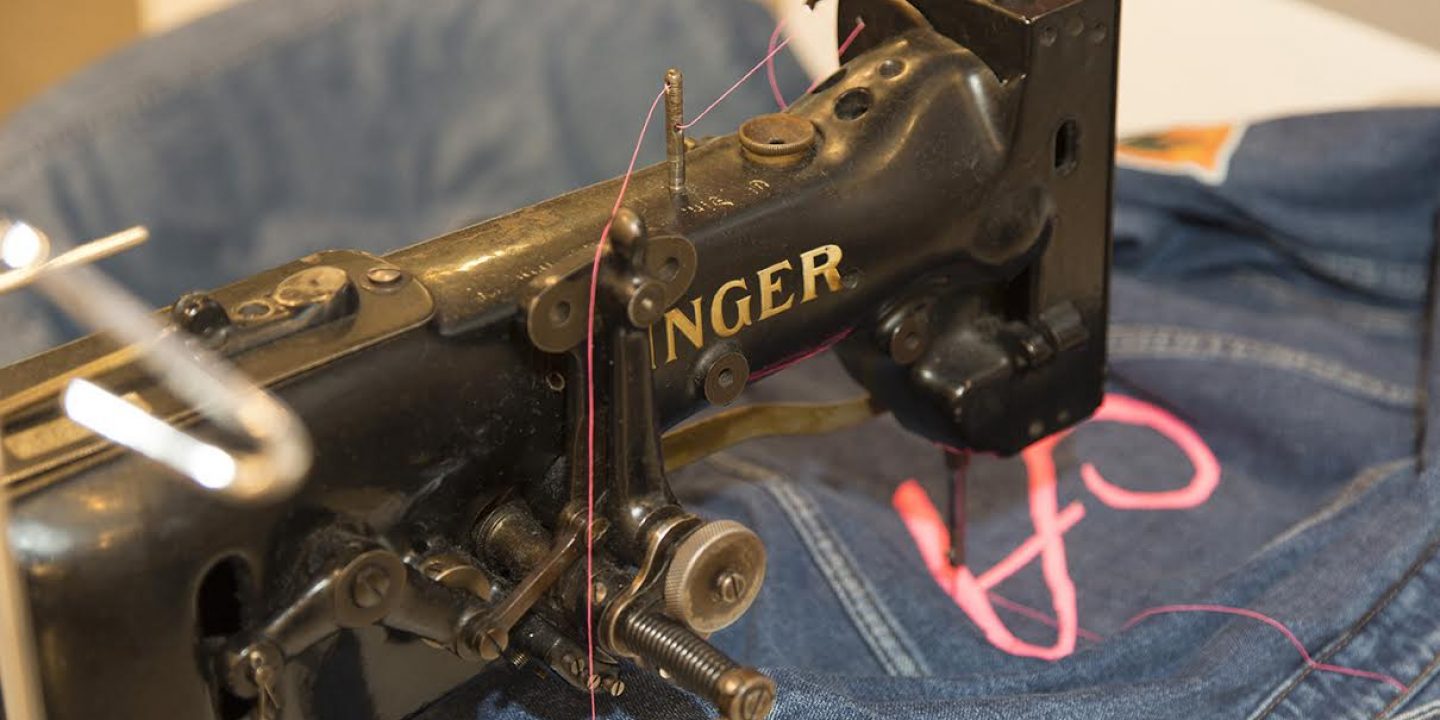

Step inside the double-height cloisters of Hand & Lock, and you enter a reception room that instantly casts you back in time. Deep red walls are lined with dark wooden boxes with labels such as, “Diamanté mounts/cross back/ 444g/ silver 5mm x 5mm” and “Sapphire half cut beads/ 1mm”; there’s a framed handwritten letter from Cecil Beaton, and a vast velvet banner from the Diamond Jubilee that tells the story of the house’s longstanding relationship with royalty.
The history of Hand & Lock begins with M. Hand, a Hugenot refugee lacemaker from Flanders, who added embroidery to his services when he founded M Hand & Co in 1767. Spending much of his time occupied with ceremonial work for the military and royalty, he eventually gained the royal warrant.
Then, in 1956, a young designer called Stanley Lock was working for the 1898-founded CE Phipps & Co, creating embroidery for the top fashion designers of his day, such as Norman Hartnell and Christian Dior. Taking over the reins when Mr Phipps retired, Lock boldly renamed the company after himself.
In 1998, Alastair Macleod (himself from a family of tailors) acquired M Hand & Co and, in 2001, merged the two businesses to produce Hand & Lock, combining Hand’s stately decoration with Lock’s stylish flair.
Today, the mix of traditional versus high-fashion work covers military, royal and ecclesiastical commissions to jobs for designers including Burberry and Anya Hindmarch. While commissions from the clergy can involve restoration work of historic pieces, the team was recently approached to design an altar cloth from scratch for a church in Westminster. Likewise, military orders placed daily from around the world (for the RAF, US Navy and Royal Marines, as well as enthusiastic collectors) are mostly for standard beret badges, epaulettes and aiguillettes, but recently the house was asked to create a badge for a new regiment. Theatres order runs of handmade synthetic braid to mimic the goldwork for costumes when budgets and deadlines run too tight to accommodate the real thing. For Michael Jackson, however, there was no expense spared: the gold work for the sumptuous Gieves & Hawkes tailcoat designed for his late-1980s Bad tour is one of the finest examples of Hand & Lock hand embroidery.
“If you were to commission one today, it would cost in the region of £75,000,”
Monogramming is another speciality. Walk-in customers bring armfuls of shirts while fashion houses including Dior, Fendi and Stella McCartney come for bespoke in-store monogramming events. They initial everything from pyjamas to velvet dress slippers for Savile Row’s top names including Turnbull & Asser, Gieves & Hawkes, Anderson & Sheppard, Kilgour and Spencer Hart, while tailors such as Henry Poole & Co entrusts them with officers’ military badges. “We have a lot of students and new designers coming to collaborate with us,” adds head embroiderer Janika Mägi, citing Fashion East’s Ed Marler and emerging menswear designer Grace Wales Bonner. “It’s great because they bring us new ideas, and we can combine these with historical techniques.”
The diversity of the work appeals to production director Jessica Pile, who trained in costume design at the Central School of Speech and Drama and joined the team four years ago.
“One day I’m working on Louis Vuitton, the next on someone’s dressing gown.” Pile, just 26, heads up the small but dynamic team of seven, also mostly in their mid to late twenties. Expert freelancers are drafted in when additional manpower is required, such as for a one-of-a-kind Nicholas Oakwell gown for the Great Festival of Creativity in Shanghai, where 400 hours of ombre featherwork were squeezed into six days by 17 embroiderers.
The young team is eager to emphasise the importance of hand-embroidery within a fashion industry that is becoming increasingly steered by mass production and pinched margins. For spring/summer 2015, Hand & Lock launched an in-house collection to showcase the team’s talents, one of the Initiatives spearheaded by Pile, who views her role as to, “push things forward. My job is to extend the classes, the tours, the prize – making sure that we are out there and we’re known.”
Running since 2001 and with £26,000 prize money at stake, the annual Hand & Lock Prize for Embroidery receives strong interest. “Winners often go on to use the prize fund to establish their own businesses,” says Communications manager Robert McCaffrey. Evening and weekend workshops have proved so popular that, when the company travelled to New York last year, attendees flew in from Columbia and Israel.
At every turn, signs of modernisation are creeping into the historical house, necessary to keep the business both relevant and profitable. The team sketch with pencil on paper at their desks but communication is via email on Apple Mac computers. Tired-looking, tiny cardboard boxes stuffed with military badges and frogging are gradually being replaced by metal drawers labelled with barcodes.
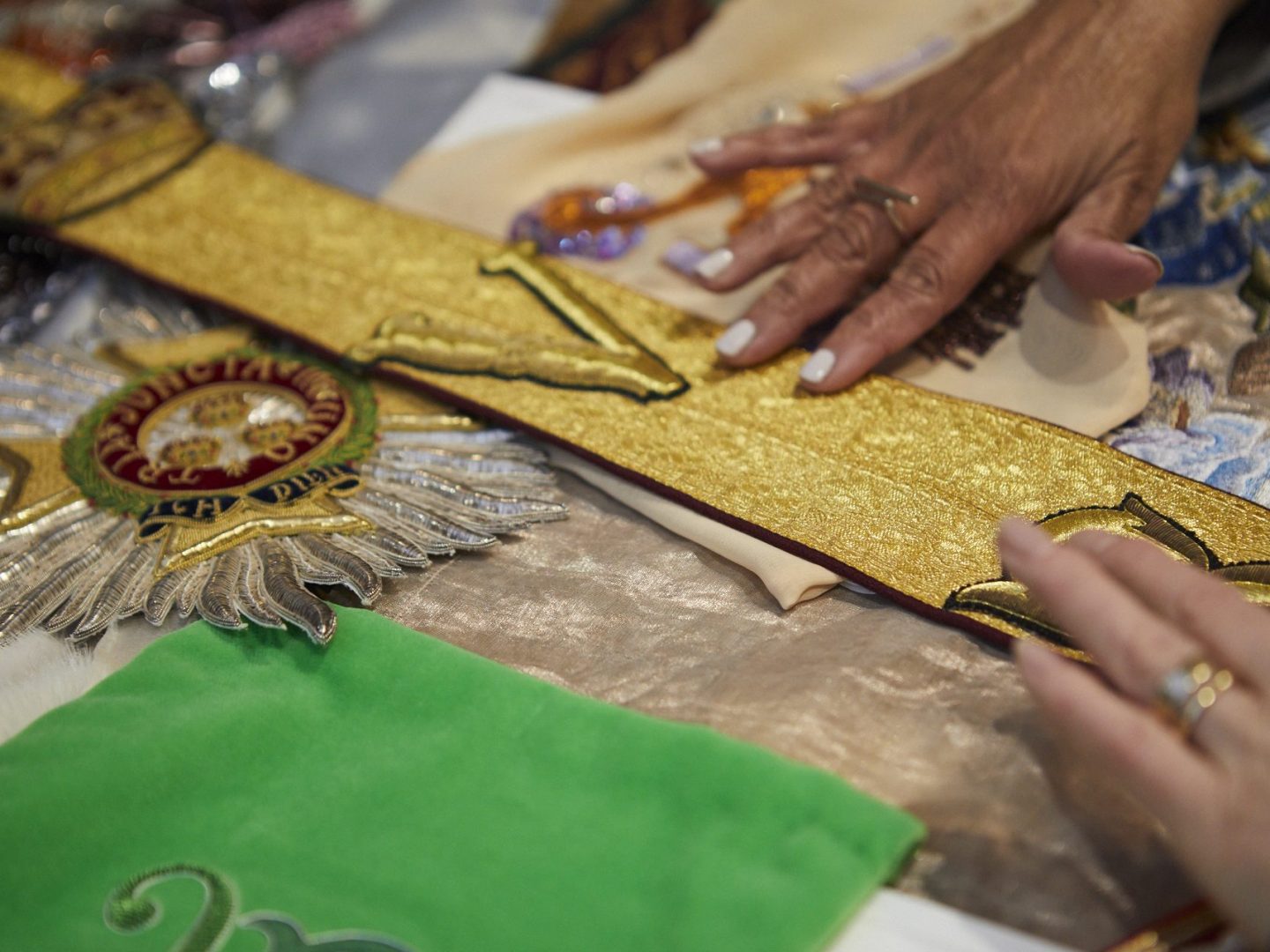
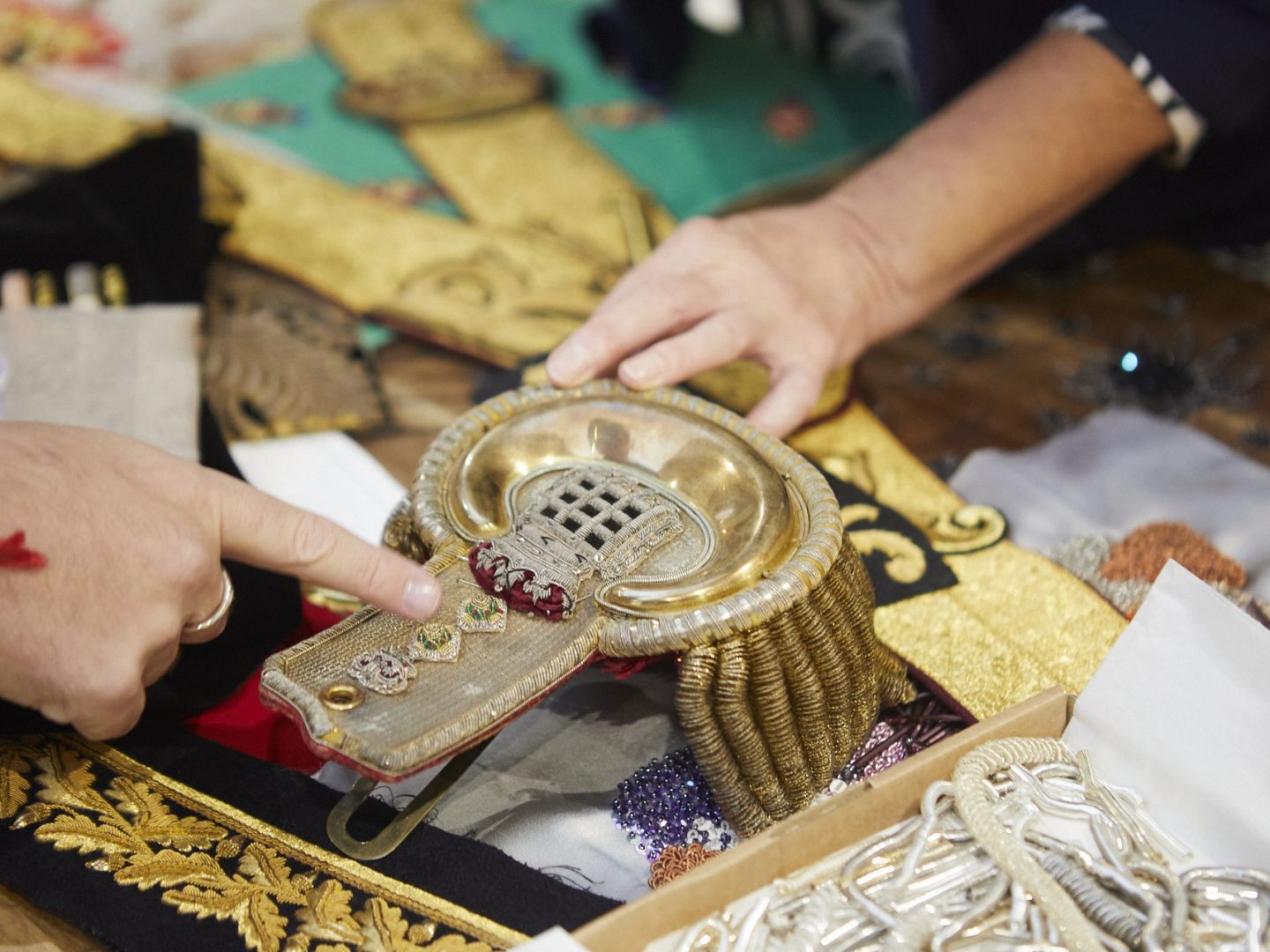
Designers like Mary Katrantzou and Kim Jones at Louis Vuitton use us because we are in London and they can easily see the work
Opening a drawer labelled “RAF Wings”, McCaffrey pulls out a cap badge. “They’re like little gems,” he enthuses. “It’s insanely complicated and delicate,” he says, gesturing to the goldwork. “The threads are actually foam wire coils cut to size, threaded through the centre, pinned down and then edged with another wire stitch called pearl-purl.”
Holding up a roll of shimmering ribbon, he says, “This is two per cent gold, so it’s cold if you hold it to your cheek. It tarnishes over time, it’s a living breathing fabric.” Silver thread is sealed in lightproof bags and stored in metal drawers to prevent damage. “This is for people who have the money and want to do things properly.”
Many designers sample work here that may then be passed over to in-house embroidery teams if the pieces go into production. They have created badges for Chanel and broderie anglaise for Alexander McQueen, and personalised blankets for Burberry.
“Designers like Mary Katrantzou and Kim Jones at Louis Vuitton use us because we are in London and they can easily see the work,” explains Pile, who has worked with Louis Vuitton for several seasons. Her first commission was a collaboration between the Paris house and the Chapman Brothers.
“If you were to pull the dress apart you would see how many layers of development we went through.”
“We did a huge piece of work for Mary Katrantzou for autumn/winter 2014, which took 250 hours of embroidery,” says Mägi. “We had to work out how we were going to build her design,” which included layers of soft string padding, tambour beading, goldwork and silk shading. “If you were to pull the dress apart you would see how many layers of development we went through.”
Computers aside, little has changed at Hand & Lock over the past 250 years. Trestles with organza or velvet pulled tight between two runners edged with paper so as not to damage the fabric look just as they would have done two centuries ago – only now the wooden frames are slightly raised to accommodate modern, taller staff.
The most recent advancement is tracing paper, used in the process of marking up a monogram, which used to be done by piercing a large copper sheet with manually operated machinery and pushing a paste of cuttlefish and charcoal through the pinpricks.
Hand embroidery is time-intensive; there are no short cuts. “You can never rush it,” says head designer Scott Heron, who joined five years ago after entering the Hand & Lock Prize. Just 28, Heron’s services have been sought by names including Tom Ford and Gieves & Hawkes. He completed a textiles degree at Nottingham Trent University where, he says, “My tutors opened my eyes to Parisian fashion houses and couture embroiderer François Lesage.”
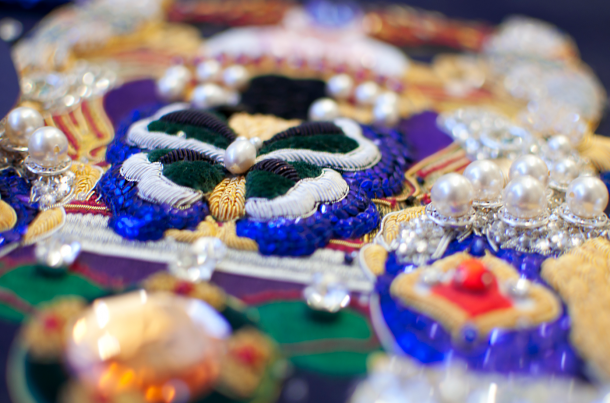
“There were all these amazing drawings by Jake and Dinos Chapman that I had to replicate into embroidery using lots of beads and padding. I even sewed paint brushes into it.”
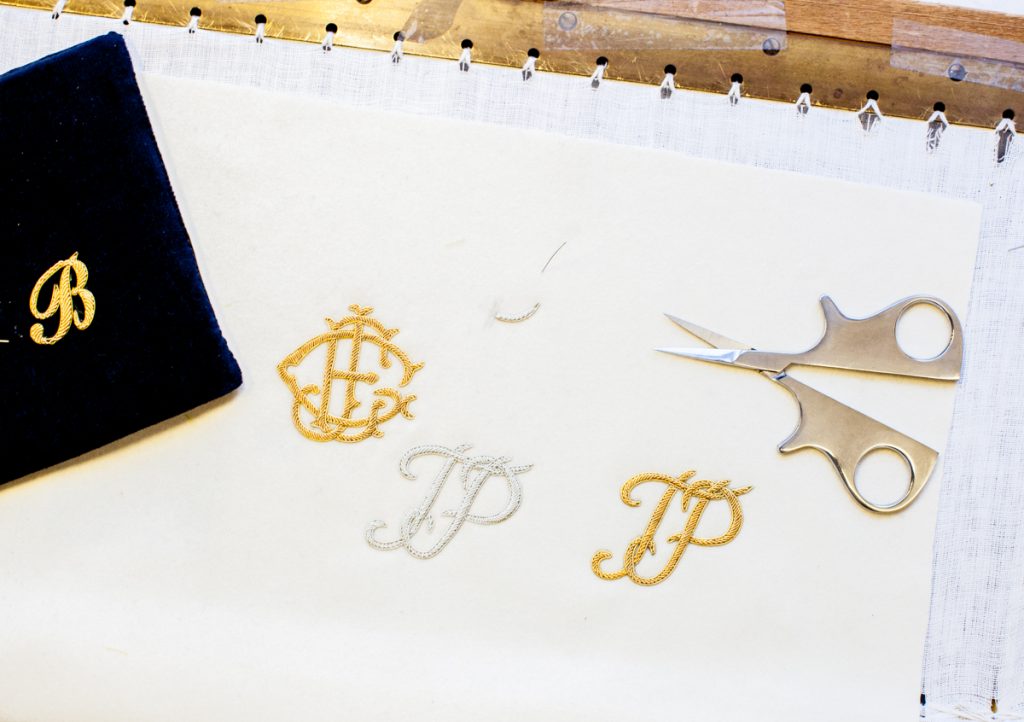
Heron specialises in the detailed annotated drafts that function similarly to an architect’s blueprint. “The annotations show different techniques, materials and levels of relief. Everything must be drawn to scale, including sequins or crystals, and indicating stitch direction is crucial, especially with goldwork, because you’re working with the material’s reflective properties.”
The youthful team has a pioneering outlook for the future. Design assistant Laura Campbell, 24, graduated from Northumbria University three years ago and has since interned with Erdem. “I think at the end of the day, it’s got to make money,” she says, matter-of-factly. “When I came here, I had the idea of using embroidery in a more accessible way. In our last collection, we used sportswear as the inspiration, to show it can be worn, you can move in it.”
In a recent audit of the archive, the team discovered a ledger containing samples of military badges dating back pre-First World War. The book will undergo a two-year restoration process, before embarking on an international tour that is in the pipeline. “You do feel a sense of legacy,” says Heron. “We’ve got an archive that spans the entire history of our company,” McCaffrey says. “People think goldwork is done by machine and we’re the ones telling them it’s not. We need to get out there and keep beating the drum for hand embroidery.” The article was also published in The Telegraph.
